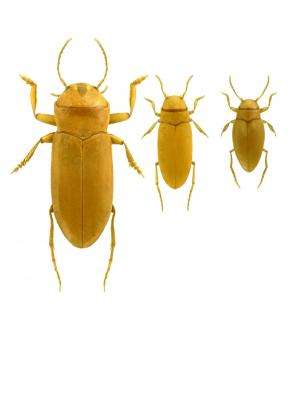Blind beetles show extraordinary signs of sight

University of Adelaide researchers have made a surprising discovery in the aquifers beneath the Western Australian desert, which challenges the traditional Darwinian view of evolution.
A team, lead by Dr Simon Tierney, discovered that a species of blind predatory water beetles - living underground for millions of years - express vision genes (opsin) which are usually only found in species with eyes. The research was published in the reputable journal, Royal Society Open Science.
"Opsin proteins form visual pigments which turn photons of light into a signal that is sent to the brain. We expect to find opsin in beetles living above ground but to find them in those living in the dark is extraordinary," says Dr Tierney, a Postdoctoral Researcher from the University of Adelaide's School of Biological Science.
"The presence of these gene products is unusual, not only because there is no light to activate the signalling pathways (biochemical cascades) underground, but because these beetles are also eyeless," he says.
According to Dr Tierney, the genetic mechanisms that lead to the reduction of traits over time (regressive evolution) has intrigued biologists for hundreds of years because traditional Darwinian views of evolution as an adaptive process may not necessarily apply.
"Evolution is often perceived as a 'directional' or 'adaptive' process but this is not always the case. These beetles have provided us with credible preliminary evidence for non-adaptive evolution," says Dr Tierney.
"Non-adaptive evolution or Neutral Theory is when there is no selective pressure on a gene, resulting in an accumulation of random mutations in the gene sequence over time," he says.
Dr Tierney and his team used advanced molecular biology techniques (next-generation sequencing) to compare three subterranean beetle species with two closely related surface dwelling species. Opsin gene products were found in all surface species and in one of the three subterranean beetle species studied.
"Our results broadly conform to non-adaptive evolutionary theory and the discovery of a functional opsin in one underground species may indicate either a secondary role for opsin, known as pleiotropy, or the amount of time spent underground," says Dr Tierney.
To date, there are approximately 100 known subterranean beetle species living in isolated underground caves.
Dr Tierney believes these beetles will provide one of the most informative systems for biologists to explore the mechanisms responsible for regressive evolution because multiple comparisons can be made between species, which will produce a high sample size for statistical assessment.
"Our study has made a significant contribution in understanding how regressive evolution may operate under a non-adaptive evolutionary process," he says.
The University of Adelaide is recognised as an international leader in evolutionary biological research earning a 5 (rated well above world standard) in the latest Excellence in Research Australia results.
Journal information: Royal Society Open Science
Provided by University of Adelaide




















